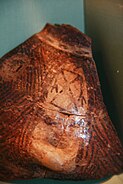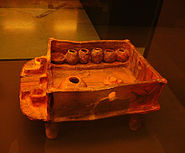Template:Toofewopinions Template:History of religion Prehistoric religion is a general term for the religious beliefs and practices of prehistoric peoples. More specifically it encompasses Paleolithic religion, Mesolithic religion, Neolithic religion and Bronze Age religion.
Paleolithic[]
Burial[]

Picture of a half animal half human being in a Paleolithic cave painting in Dordogne, France archeologists believe that cave paintings of half animal half human beings may be evidence for early shamanic practices during the Paleolithic.
Intentional burial, particularly with grave goods may be one of the earliest detectable forms of religious practice since, as Philip Lieberman suggests, it may signify a "concern for the dead that transcends daily life."[1]
The earliest undisputed Homo sapiens burial dates back 60,000 years. Human skeletal remains stained with red ochre were discovered in the Skhul cave at Qafzeh, Israel.
Animal worship[]
A number of archeologists propose that Middle Paleolithic societies such as Neanderthal societies may also have practiced the earliest form of totemism or animal worship. Emil Bächler in particular suggests (based on archeological evidence from Middle Paleolithic caves) that a widespread Middle Paleolithic Neanderthal bear cult existed (Wunn, 2000, p. 434-435). Additional evidence in support of Middle Paleolithic animal worship originates from the Tsodilo Hills (c 70,000BCE) in the African Kalahari desert where a giant rock resembling a python that is accompanied by large amounts of colored broken spear points and a secret chamber has been discovered inside a cave. The Broken spear points were most likely sacrificial offerings and the python is also important to and worshipped by contemporary Bushmen Hunter-gatherers who are the descendants of the people who devised the ritual at the Tsodilo Hills and may have inherited their worship of the python from their distant Middle Paleolithic ancestors.[2] Animal cults in the following Upper Paleolithic period, such as the bear cult, may have had their origins in these hypothetical Middle Paleolithic animal cults.[3]
Animal worship during the Upper Paleolithic was intertwined with hunting rites.[3] For instance, archeological evidence from art and bear remains reveals that the Bear cult apparently had a type of sacrificial bear ceremonialism in which a bear was shot with arrows and then was finished off by a shot in the lungs and ritualistically buried near a clay bear statue covered by a bear fur with the skull and the body of the bear buried separately.[3]
Neolithic[]
There are no extant textual sources from the Neolithic era, the most recent available dating from the Bronze Age, and therefore all statements about any belief systems Neolithic societies may have possessed are glimpsed from archaeology.
The archaeologist Marija Gimbutas put forward a notion of a "woman-centered" society surrounding goddess worship throughout Pre History (Paleolithic and Neolithic Europe) and ancient civilizations, by using the term matristic "exhibiting influence or domination by the mother figure".
She describes a matriarchal "Old Europe" set of societies dominated by goddess worship, in particular postulating a bird goddess and a bear goddess. Gimbutas considered the Bronze Age Minoan civilization a native continuation of Neolithic Europe, with the labrys and bull worship continuing symbols of matriarchal power. However, these views are questioned by the majority of the scientific community. Archaeologist Sarah M. Nelson criticizes Gimbutas suggesting that she used the same techniques used in the past to disparage women but in this case to glorify them, and quotes another archaeologist, Pamela Russell as saying ""The archaeological evidence is, in some cases, distorted enough to make a careful prchistorian shudder".[4]
Bronze Age[]
Template:Bronze Age
Reconstructions[]
The early Bronze Age Proto-Indo-European religion (itself reconstructed), and the attested early Semitic gods, are presumed continuations of certain traditions of the late Neolithic.
Archaeology[]
Bronze Age Europe[]
Hints to the religion of Bronze Age Europe include images of solar barges, frequent appearance of the Sun cross, deposits of bronze axes, and later sickles, so-called moon idols, the conical golden hats, the Nebra skydisk, and burial in tumuli, but also cremation as practised by the Urnfield culture.
Iron Age[]
While the Iron Age religions of the Mediterranean, Near East, India and China are well attested, much of Iron Age Europe, from the period of about 700 BC down to the Great Migrations falls within the prehistoric period. There are scarce accounts of non-Mediterranean religious customs in the records of Hellenistic and Roman era ethnography.
- Scythian mythology (Herodotus)
- Celtic polytheism (Posidonius)
- Paleo-Balkans mythology
- Germanic polytheism (Tacitus)
- Slavic polytheism (Procopius)
- Altaic mythology
In the case of Circumpolar religion (Shamanism in Siberia, Finnic mythology), traditional African religions, native American religions and Pacific religions, the prehistoric era mostly ends only with the Early Modern period and European colonialism. These traditions were often only first recorded in the context of Christianization.
See also[]
- Ancestor worship
- Anthropology of religion
- Bear worship
- Bull worship
- Circular ditches, Goseck circle
- Development of religion
- Fire worship
- Ġgantija
- Goddess
- Henge, Stonehenge
- Horse sacrifice
- Megalithic tomb, Tumulus
- Moon worship
- Religions of the ancient Near East
- Sacral king
- Sun worship
- Tarxien Temples
- Urmonotheismus
Notes[]
- ^ Christopher L. C. E. Witcombe, "Women in the Stone Age," in the essay "The Venus of Willendorf" (accessed March 13, 2008).
References[]
- ↑ Uniquely Human. 1991. ISBN 0674921836. http://books.google.com/books?id=3tS2MULo5rYC&pg=PA162&dq=Uniquely+Human+cognitive-linguistic+base&ei=nNUeR9fmBo74pwKwtKnMDg&sig=3UsvgAnE5B-vzb55I6W6OqqhJy4.
- ↑ World's Oldest Ritual Discovered – Worshipped The Python 70,000 Years Ago The Research Council of Norway (2006, November 30). World's Oldest Ritual Discovered – Worshipped The Python 70,000 Years Ago. ScienceDaily. Retrieved March 2, 2008, from http://www.sciencedaily.com/releases/2006/11/061130081347.htm
- ↑ 3.0 3.1 3.2 Karl J. Narr. "Prehistoric religion". Britannica online encyclopedia 2008. http://concise.britannica.com/oscar/print?articleId=109434&fullArticle=true&tocId=52333. Retrieved 2008-03-28.
- ↑ Nelson, Sarah M (2004). Gender in archaeology: analyzing power and prestige. AltaMira Press. p. 132. ISBN 978-0759104969. http://books.google.com/books?id=46UlbBqCE9AC&pg=PA130&dq=neolithic+religion&hl=en&ei=B-tJTMb6G4__Ocaw2ZgD&sa=X&oi=book_result&ct=result&resnum=1&ved=0CCUQ6AEwAA#v=onepage&q=pamela%20russell&f=false.
Sources[]
- Marija Gimbutas, The Goddesses and Gods of Old Europe (1974)
- Marija Gimbutas, The Language of the Goddess (1989)
- Marija Gimbutas, The Civilization of the Goddess (1991)
| ||||||||||||||||||||
| ||||||||||||||||||||||||||||||||||||||||||||||||||||||
ja:原始宗教 no:Forhistorisk religion zh:原始宗教











